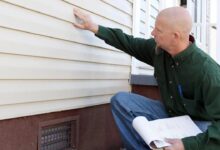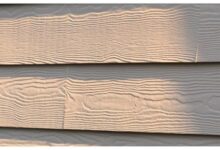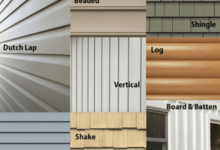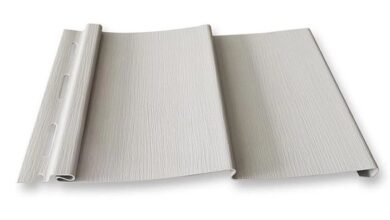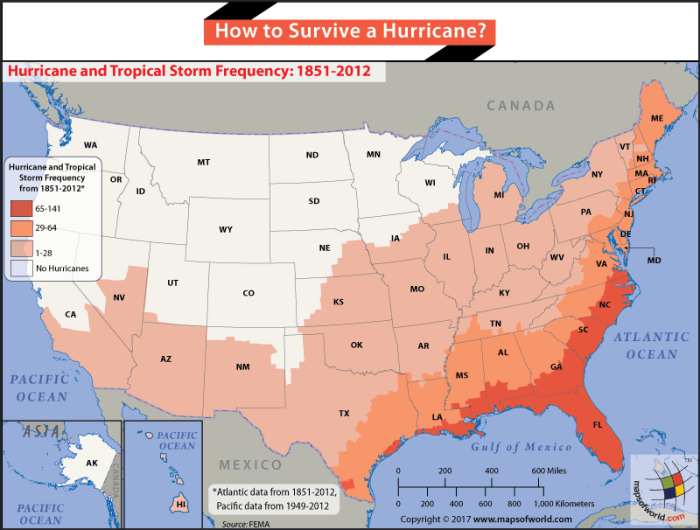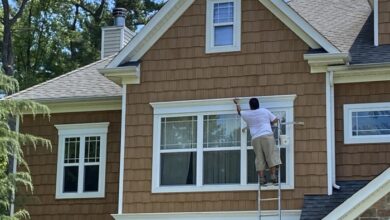Siding Repair Costs A Comprehensive Guide
Siding Repair Costs: Understanding the true price of restoring your home’s exterior is crucial. From minor cracks to extensive damage, the cost of siding repair can vary wildly depending on several key factors. This guide delves into the intricacies of siding repair, equipping you with the knowledge to make informed decisions, whether you’re tackling a DIY project or hiring a professional.
We’ll explore the impact of siding material, damage extent, labor complexities, and hidden costs like permits and disposal. Get ready to navigate the world of siding repair with confidence.
This in-depth analysis will break down the costs associated with different siding materials (vinyl, wood, fiber cement), repair methods (patching, replacement), and project scopes. We’ll compare DIY versus professional approaches, highlighting the potential cost savings and risks involved in each. Ultimately, understanding these factors empowers you to budget effectively and choose the best approach for your specific situation, protecting your investment and enhancing your home’s curb appeal.
Factors Influencing Siding Repair Costs

Repairing your home’s siding is a significant investment, and understanding the factors that influence the final cost is crucial for budgeting and planning. Several key elements contribute to the overall expense, from the type of siding to the extent of the damage and the labor involved. This breakdown will help you navigate the complexities of siding repair pricing.
Siding Material and Repair Costs
The material your siding is made from significantly impacts repair costs. Vinyl siding, known for its affordability and ease of maintenance, generally requires less expensive repairs than other options. Minor repairs, such as replacing a few damaged panels, might only cost a few hundred dollars. However, extensive damage could necessitate a more significant investment. Wood siding, while aesthetically pleasing, is susceptible to rot, insect infestation, and weathering, leading to higher repair bills.
Repairing wood siding often involves more intricate work, potentially including carpentry skills to replace damaged sections and ensure a seamless finish. Fiber cement siding, a durable and long-lasting alternative, typically falls somewhere between vinyl and wood in terms of repair costs. Its strength and resistance to damage can mean fewer repairs overall, but when repairs are needed, specialized tools and techniques might be required, driving up the cost.
Extent of Damage and Pricing
The severity of the damage directly correlates with the repair cost. Minor cracks or small holes in vinyl siding are relatively inexpensive to fix, often involving patching or replacing a single panel. Larger sections of damaged siding, however, require more extensive work, potentially involving the removal and replacement of multiple panels or even entire sections of wall. Significant damage, such as that caused by severe weather events or impact, will inevitably increase the overall expense.
For example, replacing a few damaged vinyl panels might cost a few hundred dollars, whereas replacing an entire wall section could easily reach several thousand. Similarly, wood siding repairs range from minor patching to complete board replacement, significantly impacting the final cost.
Labor Costs and Project Complexity
Labor costs are a substantial portion of any siding repair project. The size and complexity of the job significantly influence this factor. A small repair job involving only a few panels might take a contractor a couple of hours, while a large-scale project could take several days or even weeks to complete. Specialized skills, such as those needed for intricate wood repairs or working with fiber cement, will also increase labor costs.
The contractor’s experience and reputation also play a significant role, with more experienced professionals often charging higher hourly rates. It’s important to get multiple quotes to compare labor costs before making a decision. For example, a simple vinyl repair might cost $50-$100 per hour, while more complex wood repairs could easily exceed $100 per hour.
Additional Costs: Permits, Disposal, and Cleanup
Beyond the cost of materials and labor, several additional expenses can arise. Depending on your location and the scope of the repair, permits might be required, adding to the overall cost. Proper disposal of old siding materials is also essential, and disposal fees should be factored into your budget. Finally, cleanup is crucial to ensure the project leaves your property clean and organized; this may be included in the contractor’s quote or be an additional charge.
These seemingly small expenses can add up quickly, so it’s wise to factor them into your planning.
Average Cost Comparison Per Square Foot
| Siding Type | Average Cost/sq ft (Low) | Average Cost/sq ft (High) | Factors Influencing Cost |
|---|---|---|---|
| Vinyl | $2 | $8 | Extent of damage, labor costs, material quality |
| Wood | $5 | $20 | Type of wood, condition of existing siding, labor complexity |
| Fiber Cement | $4 | $15 | Extent of damage, specialized tools and labor |
Types of Siding Repairs and Their Costs
Siding repair costs can vary dramatically depending on the extent of the damage, the type of siding, and the chosen repair method. Understanding these factors is crucial for homeowners planning repairs or replacements, allowing for accurate budgeting and informed decision-making. This section delves into the specifics of common siding repair types and their associated costs, providing a practical guide for navigating this often complex process.
Siding Repair Methods and Associated Costs
Repairing siding damage involves several techniques, each appropriate for different types of damage and levels of severity. Minor issues, such as small cracks or holes, can often be addressed with relatively inexpensive methods. More extensive damage, however, might necessitate complete panel replacement, significantly impacting the overall cost. Caulking is a simple and affordable solution for sealing gaps and cracks, preventing water damage.
Patching involves filling small holes or cracks with matching materials, a relatively inexpensive solution for minor damage. For more significant damage, however, replacing damaged sections or entire panels is often necessary. The cost of replacement varies significantly depending on the type of siding, the size of the area needing replacement, and the labor costs in your region. For instance, replacing a single damaged vinyl siding panel might cost between $50 and $150, while replacing a large section of wood siding could easily reach several thousand dollars.
The choice of repair method directly influences the final cost; choosing a simpler, less expensive method when appropriate can lead to significant savings.
Cost Differences Between Minor and Major Repairs
The difference in cost between repairing minor damage and replacing large sections of siding is substantial. Minor repairs, such as caulking or patching small holes, typically cost between $50 and $200, depending on the materials and labor required. These repairs can often be completed by a homeowner with basic DIY skills, further reducing the overall cost. In contrast, replacing large sections of siding, particularly if specialized tools or expertise are needed, can cost several hundred to several thousand dollars.
Consider, for example, a scenario where a homeowner notices a few small cracks in their vinyl siding. Repairing these cracks with caulk would be a relatively inexpensive solution. However, if a significant storm caused extensive damage, requiring the replacement of multiple panels, the cost would increase exponentially. The cost per square foot for replacement can range from $5 to $30 or more, depending on the siding material and labor rates.
Cost Implications of Different Repair Techniques, Siding Repair Costs
Different repair techniques carry varying cost implications. Caulking is the most economical option for addressing minor gaps and cracks, typically costing less than $20 per tube of high-quality caulk, and requiring minimal labor. Patching, while more involved than caulking, remains relatively inexpensive for small areas. The cost of patching materials is usually minimal, but labor costs might increase depending on the complexity of the repair.
Replacement, on the other hand, is the most expensive option, with costs escalating significantly based on the area needing replacement, the type of siding (wood, vinyl, fiber cement), and labor rates. For instance, replacing a single damaged cedar shingle might cost significantly more than replacing a single vinyl panel due to the higher material and labor costs associated with wood siding.
Repair vs. Replacement: Cost-Effectiveness Scenarios
The decision to repair or replace siding depends heavily on the extent of the damage and the overall cost-effectiveness. Repairing minor damage, such as small cracks or holes, is usually cost-effective, especially if the homeowner can perform the repairs themselves. However, if the damage is extensive, or if the siding is old and nearing the end of its lifespan, complete replacement might be a more economical long-term solution, preventing future repair costs and ensuring improved energy efficiency.
For example, if a homeowner has several panels damaged by a storm, repairing each individually might seem cost-effective initially. However, the cumulative cost of multiple repairs might exceed the cost of replacing a larger section or even the entire siding system, especially considering potential future repairs.
Steps in a Typical Siding Repair Project and Cost Estimates
Understanding the steps involved in a typical siding repair project provides a clearer picture of the associated costs.
- Assessment and Diagnosis: This involves inspecting the damaged area to determine the extent of the damage and the necessary repair method. Cost: $50 – $150 (depending on the complexity of the inspection and the need for specialized equipment).
- Material Procurement: Purchasing the necessary materials, such as caulk, patching compound, or replacement siding panels. Cost: Variable, depending on the materials needed and their cost.
- Preparation: Cleaning and preparing the damaged area for repair. Cost: Included in labor costs for professional repairs; minimal for DIY repairs.
- Repair Execution: Performing the actual repair work, whether caulking, patching, or replacing siding panels. Cost: $50 – $200+ per hour for labor, depending on the complexity of the repair and the contractor’s rates.
- Clean-up: Cleaning up the work area after the repair is complete. Cost: Included in labor costs for professional repairs; minimal for DIY repairs.
Finding and Hiring Qualified Siding Repair Contractors: Siding Repair Costs
Choosing the right contractor for your siding repair is crucial for a successful project and long-lasting results. A poorly executed repair can lead to further damage and increased costs down the line, highlighting the importance of thorough research and careful selection. This section provides guidance on identifying reliable professionals and ensuring a smooth, problem-free repair process.
Identifying Reputable and Experienced Contractors
Finding a reputable contractor involves more than just checking online reviews. A thorough vetting process should include examining their experience, licensing, and insurance. Look for contractors with a proven track record of successful siding repairs, ideally with references from previous clients. Consider the length of time they’ve been in business; established companies often demonstrate greater stability and reliability.
Checking online reviews on platforms like Yelp and Google My Business can provide valuable insights into customer experiences, but remember to consider the volume and overall trend of reviews, rather than focusing solely on a few isolated instances. Pay attention to recurring themes in positive and negative reviews to gauge the consistency of the contractor’s service.
Obtaining Multiple Quotes
Securing multiple quotes from different contractors is a cornerstone of responsible project management. This practice allows for comparison of pricing, services offered, and overall value. Avoid choosing a contractor solely based on the lowest price; instead, focus on the overall package, considering factors such as experience, warranty offerings, and the perceived quality of the proposed work. A significantly lower quote compared to others may indicate a potential compromise in quality or use of inferior materials.
Request detailed breakdowns of costs in each quote to facilitate a comprehensive comparison.
Key Aspects of a Contractor Agreement
A well-defined contract is essential for protecting both the homeowner and the contractor. The agreement should clearly Artikel the scope of work, including specific repairs, materials to be used, and payment schedules. It should also specify the project timeline, including start and completion dates, and address potential delays. Crucially, the contract must include details about warranties on both labor and materials.
Ensure that all terms and conditions are clearly stated and understood by both parties before signing. Consider having a legal professional review the contract before finalizing it, especially for larger or more complex projects. For example, a contract might specify that the contractor will repair damaged vinyl siding on the south-facing wall of a house, using specific brand and type of vinyl siding, with a completion date within two weeks and a five-year warranty on both labor and materials.
Verifying Contractor Licensing and Insurance
Confirming that a contractor possesses the necessary licenses and insurance is a non-negotiable step. Contact your local licensing board to verify the validity and current status of their license. This helps ensure they operate legally and meet minimum professional standards. Additionally, request proof of general liability and workers’ compensation insurance. Liability insurance protects you from potential financial losses due to accidents or damages on your property, while workers’ compensation insurance covers medical expenses and lost wages for any injuries sustained by the contractor’s employees during the project.
Lack of proper insurance could leave you personally liable for accidents or damages.
Checklist of Questions for Potential Contractors
Before committing to a contractor, compile a comprehensive list of questions to assess their qualifications and pricing strategy. Inquire about their experience with similar projects, their approach to material selection, their warranty policies, and their methods for handling unforeseen issues. Ask about their process for obtaining necessary permits and their commitment to adhering to safety regulations. Discuss their payment terms and methods, and clarify their policy for addressing potential disputes.
Finally, request references and contact previous clients to inquire about their experiences with the contractor. A well-prepared checklist will empower you to make an informed decision, ensuring the selection of a reliable and qualified professional for your siding repair needs. For example, a question could be: “Can you provide examples of previous siding repair projects similar to mine, and may I contact those clients for references?”
DIY Siding Repair vs. Hiring a Professional
Tackling siding repairs yourself can seem appealing, promising significant cost savings. However, weighing the potential benefits against the inherent risks is crucial before grabbing those tools. This section delves into the complexities of DIY versus professional siding repair, offering a clear comparison to help you make the best decision for your home and budget.
DIY Siding Repair Suitability
Choosing between DIY and professional siding repair hinges on the type and extent of damage. Minor repairs, like replacing a single damaged panel or patching small holes, often fall within the realm of DIY capabilities for homeowners with basic handyman skills. However, more extensive projects, or those involving structural issues, should always be left to the professionals. For instance, replacing several damaged panels on a large area, dealing with water damage behind the siding, or working at significant heights are situations where professional help is strongly advised.
Cost Comparison: DIY vs. Professional
The financial implications of each approach are significant. DIY repairs typically involve only the cost of materials, potentially saving hundreds or even thousands of dollars compared to hiring a professional. However, this savings comes with caveats. Underestimating the cost of materials, needing to purchase specialized tools, or making costly mistakes during the repair process can quickly negate any perceived savings.
Professional services, while initially more expensive, often come with warranties, ensuring the work’s quality and longevity. Consider a scenario where a homeowner attempts a DIY repair and fails, requiring a professional to fix the botched job—this ultimately increases the total cost.
Risks and Liabilities of DIY Siding Repair
Attempting DIY siding repair carries inherent risks. Improper installation can lead to further damage, water infiltration, and even structural problems, potentially escalating repair costs significantly. Furthermore, working at heights or with power tools involves safety risks that professionals are trained to mitigate. Injuries sustained during a DIY project can result in additional medical expenses and lost work time.
Finally, botched repairs can void home insurance coverage if damage occurs due to improper workmanship. A professional contractor, on the other hand, is insured and liable for any damage caused during the repair process, providing peace of mind.
DIY vs. Professional Siding Repair: A Cost-Benefit Analysis
The decision ultimately boils down to a careful evaluation of your skills, the complexity of the repair, and your risk tolerance.
| Aspect | DIY | Professional | Cost Implications |
|---|---|---|---|
| Initial Cost | Low (materials only) | High (labor and materials) | Potentially significant savings with DIY, but potential for increased costs due to mistakes. |
| Time Investment | High (depending on skill and complexity) | Low (contractor handles the work) | Opportunity cost of your time versus the cost of professional labor. |
| Skill Level Required | Moderate to High (depending on repair type) | High (specialized knowledge and experience) | Potential for costly errors with inadequate skill. |
| Warranty | None | Typically included | Potential for significant additional costs if DIY repair fails. |
| Safety | Higher risk of injury | Lower risk due to professional training and safety equipment | Medical expenses and lost wages in case of injury. |
| Liability | Full liability for any damage or injury | Contractor assumes liability | Potential for significant legal and financial repercussions. |
Maintaining Siding to Prevent Costly Repairs
Proactive siding maintenance is crucial for preserving its aesthetic appeal and structural integrity, significantly reducing the likelihood of expensive repairs down the line. Regular inspections and preventative measures can extend the lifespan of your siding by years, saving you considerable time and money in the long run. This guide details a practical approach to siding maintenance, helping you identify potential problems early and avoid costly interventions.
Regular Siding Inspection Schedule
Establishing a routine inspection schedule is paramount. A twice-yearly inspection – once in spring and once in autumn – allows for the identification of minor issues before they escalate into major problems. Spring inspections focus on winter damage, while autumn checks prepare for the harsh conditions of winter. Consider more frequent inspections if your home is in a particularly harsh climate or if your siding is older and more susceptible to damage.
A thorough visual examination, paying close attention to details, is key.
Identifying and Addressing Potential Problems
Early detection of siding problems is vital. Look for signs of damage such as cracks, loose or missing pieces, discoloration, warping, or signs of insect infestation. For example, a small crack in vinyl siding, if left unaddressed, can expand, leading to water ingress and eventual rot. Similarly, loose siding can allow moisture to penetrate the wall cavity, leading to mold growth and structural damage.
Addressing these issues promptly minimizes the extent of the repair and prevents further damage.
Preventative Maintenance Practices
Regular cleaning is a cornerstone of preventative maintenance. A simple pressure washing (using a low-pressure setting to avoid damage) can remove dirt, grime, and algae build-up. For more stubborn stains, consider using a mild detergent solution. After cleaning, allow the siding to dry completely before applying any sealant or protective coatings. Regularly inspect and clean gutters and downspouts to ensure proper water drainage away from the house, preventing water damage to the siding.
Minimizing the Risk of Future Damage
Protecting your siding from impact damage is crucial. Consider installing protective barriers around vulnerable areas, such as near walkways or driveways. Proper landscaping, keeping trees and shrubs trimmed away from the house, prevents abrasion and provides adequate ventilation to reduce moisture build-up. Regularly check and repair any damaged flashing around windows and doors to prevent water leakage.
Addressing these preventative measures will significantly reduce the chance of needing costly repairs in the future. For example, a strategically placed bush can protect your siding from hail damage, while proper gutter maintenance will prevent water damage, both preventing the need for expensive repair work.
Extending Siding Lifespan Through Maintenance
Proper maintenance directly correlates with extended siding lifespan. Addressing small issues promptly prevents them from becoming larger, more costly problems. For instance, repairing a small crack in your siding immediately prevents water damage, which can lead to significant structural issues requiring extensive repairs or even siding replacement. By adhering to a regular maintenance schedule and promptly addressing any issues that arise, you can significantly extend the life of your siding, saving thousands of dollars in repair costs over the life of your home.
End of Discussion
Successfully navigating siding repair requires a blend of knowledge and strategic planning. By understanding the factors influencing costs, comparing DIY versus professional options, and proactively maintaining your siding, you can effectively manage expenses and safeguard your home’s exterior. Remember to obtain multiple quotes from reputable contractors, thoroughly review contracts, and prioritize preventative maintenance to avoid costly repairs down the line.
A well-maintained exterior not only enhances your home’s aesthetic appeal but also significantly contributes to its long-term value. Armed with this comprehensive guide, you’re well-equipped to tackle any siding repair challenge with confidence and efficiency.

